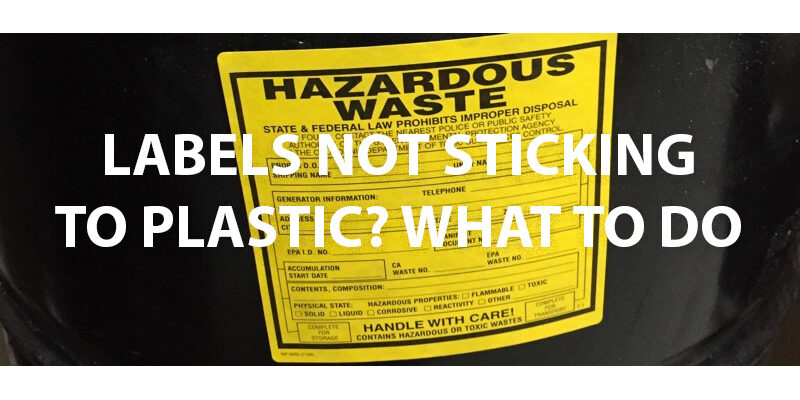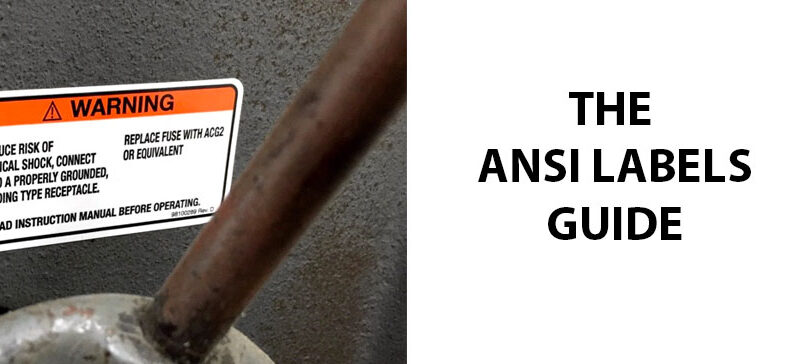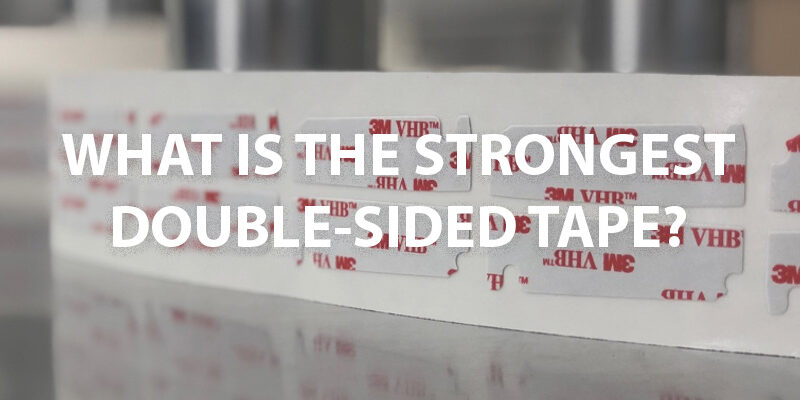Are your labels not sticking to plastic or other materials? You might be wondering how that’s possible. Labels that won’t stick as they should are a waste of your money and set back your manufacturing timelines. Worse, if your durable labels contain safety warnings, their failure to stick can put people in danger.
If you’re wondering why your durable labels aren’t sticking, read our guide to learn more about label adhesives and what might cause labels not to stick.
Why Aren’t Your Labels Sticking?
Nothing is more frustrating than receiving a shipment of labels, only to find they won’t stick to your product. The thing is, designing labels is more than just about what’s printed on top. Labels are made up of layers–face stock, adhesive, lining, and topcoat–and each layer plays a part in the durability of your labels. If your labels aren’t sticking to the surface where they’re being applied, there are a number of things that could be going on. Factors like the surface material, the face stock material, or the kind of adhesive all affect a durable label’s adhesion.
Adhesive Issues
One of the main considerations when designing your labels is the kind of adhesive to use. There are three main types of adhesives used for labels:
- Solvent acrylic-based adhesives are typically used when durability is needed. These adhesives cure over a period of time, meaning the bond between label and surface gets stronger the longer they’re in place.
- Water-based acrylic adhesives are often used for labeling health and beauty products and stationery. Water-based acrylic adhesives do not take any time to cure, meaning the adhesive is as strong as it will be upon placement.
- Rubber-based adhesives are usually used with natural products. They do not hold up to UV exposure. Rubber-based adhesives also do not cure.
If your labels have the wrong kind of adhesive for your surface, the labels won’t stick properly. For example, if you have labels not sticking to plastic, the issue could be that the plastic has a low-energy surface. In other words, the plastic is too non-stick for the adhesive to adhere. The right kind of adhesive has to be matched to the exact kind of plastic used.
Another issue with adhesives occurs if the adhesive isn’t thick enough. Surfaces that are textured or porous need a thicker layer of adhesive. A thicker layer adhesive is able to fill in the gaps and adhere to more surface area than a thin layer. When the adhesive is too thin, the label doesn’t stick to enough surface area, and the label will lift or fall off.
Contamination Issues
If the adhesive isn’t the issue, contamination might be causing your labels not to stick. For adhesives to work as intended, they need a clean surface. Dust and dirt on the surface of the label are being applied to will prevent the adhesive from properly bonding. Make sure your products or surfaces are properly cleaned before applying your labels.
Contamination from the product itself is another issue that can cause labels to peel off instead of sticking. If your product is oil-based and spills on the label, the oil can interfere with the adhesion of your labels.
Additionally, touching the sticky part of your label before placing it can make the adhesive fail. Oil, sweat, and dirt from your hands will prevent the adhesive from working. If your labels aren’t sticking, changing the way you apply them could solve the problem.
Environmental Concerns
Do your labels stick initially but then begin to lift or fall off a day or two later? Environmental factors such as temperature and the presence of moisture will affect the adhesion of your labels. For best results, labels should be applied at room temperature. You’ll also want to give your labels 24 hours to cure. Even exposure to heat or cold shortly after application can cause the label not to stick. If you need to apply your labels in the extreme cold, you’ll likely need a special kind of adhesive that won’t crystallize in freezing temps.
What Are Pressure Sensitive Labels?
Labels That Won’t Stick to Certain Surfaces
In addition to the environment, contamination, and the kind of adhesive, another factor that causes some labels not to stick is the shape of the surface. The best kind of surface for labels is a flat surface. Any kind of curves or ridges can cause the label to lift away from the product. Additionally, textured or porous surfaces can be trickier to stick labels to.
When labeling curved surfaces, you’ll need to consider what kind of face stock to use. A rigid face stock made from paper, laminate, PET, or PP will try to straighten out and go back to its original shape. This will cause the label to lift before the adhesive has time to cure.
You can work around this in a couple of ways. First, you might choose a stronger adhesive that cures faster. This will prevent the rigid material from straightening before the adhesive is at its maximum strength. You can also have your label overlap so that it’s sticking to itself. This works well if you don’t want to pay the cost of a stronger adhesive. If you do this, make sure to consider the overlap in the design of your label so that important information or artwork isn’t covered. Another solution for labeling curved surfaces is to change the material of your face stock. Opting for a flexible face stock will solve the problem if rigid material is the issue.
What Labels Are Best for Industrial Use?
Whether it’s during the manufacturing or shipping process, exposure to extreme environments or rough handling can prevent labels from sticking. Extreme heat can melt adhesive and break down the face stock. Extreme cold might make the labels go rigid and fall right off. Exposure to water or solvents can interfere with the chemical properties of adhesives. Finding that your labels are not sticking to plastic, metals, or other materials is downright frustrating. So what are the best kinds of labels for industrial use? The answer depends on the environment your labels will be exposed to.
- For products that will encounter brief water exposure, water-resistant labels are an affordable, durable solution.
- If your labels will be exposed to water for long periods of time, you’ll want to opt for waterproof labels. Waterproof labels are engineered to remain adhered to even when wet.
- For exposure to extreme heat or cold, you’ll want weatherproof labels. Weatherproof labels hold up well even when coming in contact with chemicals, solvents, or oils.
Conclusion On Labels Not Sticking To Plastic
When designing your labels, you’ll need to consider the surface the labels will be applied to, the temperature and other environmental factors, as well as the intended use of the product. The best durable labels for industrial use will depend entirely on your situation.
At Coast Label, we specialize in providing truly custom durable labels. We walk you through every step of the label designing process. This ensures that you won’t have issues with labels not sticking to plastic, metal, or whatever the material of your surface. Rather than leaving you to guess the right combinations of face stock and adhesive to use, we help you engineer the perfect label. With the option to create sample runs, we’ll help you make sure your durable labels will stick as intended. Contact Coast Label today for a free proposal!



